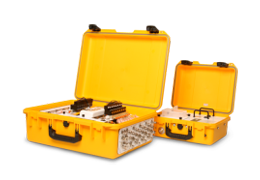Overview of the EC-5 with the LI-8100A
Printable PDF: Overview of the EC-5 with the LI-8100A
(8100_Calibration_of_ECH2O_Probes_With_a_5V_Excitation_ACU109.pdf)
Overview of the EC-5 in the LI-8100A Soil Gas Flux System.
Because of different soil moisture probe manufacturers, different probe lengths, different soil types, different excitation requirements, etc, the LI-8100A System is not set up to automatically apply a set 'q' equation. When using the 'Decagon ECH2O Probes' with the LI-8100A System, there are a few important items to consider:
First, the voltage recorded by the "V1", "V2", "V3", or "V4" channels of the LI-8100A System is in units of volts, rather than millivolts. So, for example, if the Soil Moisture Probe is connected to the "V4" channel, and a 'q' equation is being applied, the signal would need to be converted from volts to millivolts before the signal is in the correct units for Soil Water Content. As an example, if a value of 3.4 volts for "V4" is recorded, then the value of 3400 mV would need to be substituted into the equation.
However, there are some other points to consider. The equations listed in the Decagon manual are for when the probes are 'excited' using 2500 millivolts (2.5 V). The LI-8100A System actually uses 5000 mV (5 V) to 'excite' the soil moisture probes. LI-COR uses 5V as an excitation voltage since that is a standard value for various environmental sensors that require an excitation. As a result, the output from the probe is going to be slightly different and a different 'q' equation needs to be applied. Read this document from Decagon Devices to learn more about the calibration procedure for determining the coefficients for probes that are operated using 5000 mV excitation: https://licor.app.boxenterprise.net/s/qel9vh8yqvwbfdplxd7k.
Make sure to choose the right equation to use based on the length (EC-5, EC-10, EC-20) of the Soil Probe. There are two things to note here. For the EC-10 probe, there are two 'q equations' listed on the second page, both of which correlate to the 10 cm probe. The equation to choose will depend on the soil type. For the EC-5 probe, it can be seen that the equation is not linear, so a polynomial equation is used.
The LI-8100A software can compute/calculate the Volumetric Soil Water Content and 'real' water content values can be displayed for some of these probes. This will work for the EC-20 probe equation and the two EC-10 probe equations because they are linear. The slope and offset (from one of those three equations) can be programmed into the software for any of the voltage channels (for example, "V4"). However, remember that those equations are assuming that a millivolt signal is entered into the equation, rather than a volt signal, so slope values need to be multiplied by 1000 to get the appropriate units. For example, on the two EC-10 probes, the slope value will either be 0.713 or 0.437 multiplied by the "V4" value. The unchanged offsets can be subtracted after this calculation is complete. The EC-5 probe's equation is not linear so it's computed values cannot be displayed on the LI-8100A System since the voltage channels cannot be programmed for a polynomial. Only the raw voltages can be seen in real-time for this probe length and the actual water content values can be calculated later during data post-processing (using the Transform feature in Soil Flux Pro, for example).
For all the probes (and certainly for the EC-5 probes), the slope can be set to '1' and the offset to '0' so the LI-8100A System will collect the raw voltage values. A spreadsheet can later be used to apply the appropriate unit conversions and 'q' equations to get the voltage readings into appropriate Volumetric Water Content units.
